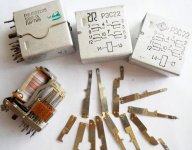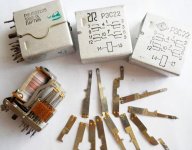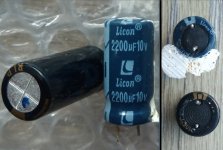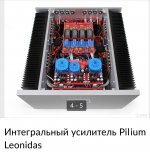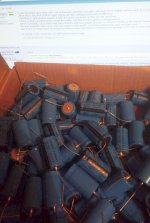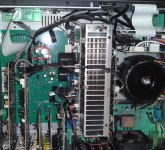Conventional, solid state relays, based on thyristors and triacs, are not suitable for audio switching for several reasons but mainly because the signal passes through those non-linear devices. They are intended for high current AC Mains power switching and fault sensing circuits would also need to be rendered compatible with them. Solid-state relay - Wikipedia
The currently popular DIY mosfet relay circuits, which use very low Rdss semis, are a different matter and have proven their worth beyond doubt here at diyAudio. They generally sense and switch via opto-couplers which isolate them from external power requirements and so are isolated within in the output stage of the amplifier. Bonsai, the member who had the nasty damaged speaker problem to begin with, inspired a long thread on the topic: Output Relays. It began an odyssey of research on the solution here and he put up his own professional solution on the Hifisonix website: http://hifisonix.com/wordpress/wp-content/uploads/2012/08/Speaker-Relay-V1.03.pdf
The currently popular DIY mosfet relay circuits, which use very low Rdss semis, are a different matter and have proven their worth beyond doubt here at diyAudio. They generally sense and switch via opto-couplers which isolate them from external power requirements and so are isolated within in the output stage of the amplifier. Bonsai, the member who had the nasty damaged speaker problem to begin with, inspired a long thread on the topic: Output Relays. It began an odyssey of research on the solution here and he put up his own professional solution on the Hifisonix website: http://hifisonix.com/wordpress/wp-content/uploads/2012/08/Speaker-Relay-V1.03.pdf
What do you think of the idea to put solid state relays instead?
I paid 500 Rupees, for a 50A / 240 volt single pole relay with heat sink, short circuit protected. Control side is 5 - 32 V DC. DIN Channel mounting
That is about $ 6.50 US.
PCB mounted ones, 16A are about $3...
More reliable, and no chance of contact noise...or wear.
1. Your relays are a bad idea.
2. 500 Rupees = 10$ ? Then I advise you to spend this money on the Chinese relays 10PCS TE TYCO Relay OSA-SS-224DM5 24VDC
Attachments
Last edited:
I know a relay made in the USSR on the contacts of which there is real gold 999,9. palladium. platinum.
(In the photo, the Soviet relay contains 0.5 grams of 999 gold on the contacts !!!!!!!!!!!!!!!!!! ) I am sure that such relays do not spoil the sound. Unfortunately, they very rarely fit the scheme.
And I'm not sure about the relays from China even if they look 1 to 1 with the native ones. Therefore, I am a supporter of restoring the NATIVE relay.
(In the photo, the Soviet relay contains 0.5 grams of 999 gold on the contacts !!!!!!!!!!!!!!!!!! ) I am sure that such relays do not spoil the sound. Unfortunately, they very rarely fit the scheme.
And I'm not sure about the relays from China even if they look 1 to 1 with the native ones. Therefore, I am a supporter of restoring the NATIVE relay.
Attachments
yes.2200 x 1000V?
Check it please...1000 is maybe a typo..
on the left is a capacitor from the Asus board, on the right is a capacitor from Arcam. the photo shows that the quality of Arcam is mediocre. Both were made in 2004-2005 years
Attachments
Last edited:
I was surprised that the capacitor swelled up. only 10 volts (the actual voltage is even less)! There is no heating next to it.
I repeat that the products of the company Arcam are very expensive. The power supply unit in the receiver is traditional, not pulsed
I repeat that the products of the company Arcam are very expensive. The power supply unit in the receiver is traditional, not pulsed
Last edited:
yes, for 3 years now, all my computers (3xx chip) are MSI. The work of MSI satisfies completely. But I note that today solid-state capacitors are used in boards. Old electrolytic capacitors swell from heating, and the capacitor is heated either by high-frequency currents in the electrical circuit (which, together with a bad ESR (this is the capacitor's own internal resistance), heat up the capacitor), or by accompanying heating from nearby parts. But not all capacitors swell. By the way, I note that solid-state capacitors are also capable of exploding.
I have faced the same issue with over enthusiastic purchase managers who want me to supply machine parts at 10 years ago prices...they just want to show their bosses how much they squeezed the supplier, quality concerns do not affect them, they find another higher paying job after getting testimonials of efficiency.
I tell them to find another supplier if after giving my cost break up they are not convinced.
I have a certain standing in the market for quality, and that includes quality of doing business.
Arcam is probably run by MBAs and bean counters, and those people are next to computer techies in job change frequency.
The poor customer? Who cares? The main object is more profit...sometimes achieved by lower purchase cost.
Also Arcam is a tiny fraction of Samsung in terms of sales, they keep it running just for prestige, or for sale to some other fool who wants to be the proud owner of a famous brand.
So nobody is very concerned, and staff turnover may be high.
I tell them to find another supplier if after giving my cost break up they are not convinced.
I have a certain standing in the market for quality, and that includes quality of doing business.
Arcam is probably run by MBAs and bean counters, and those people are next to computer techies in job change frequency.
The poor customer? Who cares? The main object is more profit...sometimes achieved by lower purchase cost.
Also Arcam is a tiny fraction of Samsung in terms of sales, they keep it running just for prestige, or for sale to some other fool who wants to be the proud owner of a famous brand.
So nobody is very concerned, and staff turnover may be high.
Last edited:
Post 5 talks about "a weak level of RF frequencies when turned on (eliminated by increasing the volume)" That is consistent with dirty speaker relay contacts. If it were about power supplies, the symptoms would be crazy, random operation. Your relay pic. shows a solid state relay but the last thing you want in-line with the load, is a solid state relay based on non-linear switching devices such as thyristors (SCRs) or triacs - unless you enjoy heaps of distortion, that isIan, he needs power relays, not speaker relays, from what I can make out in Post #1, the power on relay was cleaned....
We often see "Sugar cube" style AC power relays, designed for relatively low mains power switching and supplied in cheap speaker protection kits. They may be OK at quite low power supply voltages but the real problem for any speaker relay, is the DC current rating because a relay immediately requires considerable spring force to open when the power amplifier fails for some reason. Then, full peak DC supply current is likely flowing between the contacts. In that situation, even mains voltage rated 10 amp relays will weld their contacts together in a flash, before they can open and so you have a very expensive, rather than just a nuisance failure.
Unsealed relay contacts often become erratic after many years accumulation of contaminant film and debris forms an insulating layer over the silver plated contact faces. This has been an ongoing problem with older commercial amplifiers products since the 1970s, when speaker relays became universal. There have been many threads about this problem and solutions but opening a sealed relay charged with nitrogen, for example, is entering unknown territory. A wise repairer would not take that risk and simply replace the relay as recommended.
If you are lucky enough not to have any pitting of the contact faces yet, even a burnish with stiff paper is usually good enough to restore normal operation but in cases of newer products where you can longer remove covers to physically clean the contacts, I and others have often found that tiny pitting of the faces has already started and no amount of magic oil in a can will fix that for long. Sadly, they are kaput or soon will be....
Quote from post #1...
Arcam products automatically turn off (spontaneously).
I found the problem. The reason is the destruction of the soldering of the Relay contacts in the power supply unit.
To me it means mains input relay, around the power supply SMPS or linear supply.
I have already posted that a replacement should be reliable and good quality.
Again, clearly, I state that if needed, substitutes of good quality are still available in case the original make and type are not available.
Putting an SSR in a speaker line is not advisable, though there seems to be a thread about it on this forum.
Of course, repairing the soldering of the damaged joints may solve his problem...
Arcam products automatically turn off (spontaneously).
I found the problem. The reason is the destruction of the soldering of the Relay contacts in the power supply unit.
To me it means mains input relay, around the power supply SMPS or linear supply.
I have already posted that a replacement should be reliable and good quality.
Again, clearly, I state that if needed, substitutes of good quality are still available in case the original make and type are not available.
Putting an SSR in a speaker line is not advisable, though there seems to be a thread about it on this forum.
Of course, repairing the soldering of the damaged joints may solve his problem...
Last edited:
yes.
on the left is a capacitor from the Asus board, on the right is a capacitor from Arcam. the photo shows that the quality of Arcam is mediocre. Both were made in 2004-2005 years
Wow, things have gone really downhill then. Samwha capacitors are not bad at all, and Arcam used to use those and Rubycon before they were bought by Harman. The products used to be well made on site in England as well.
Quote from post #1...
Arcam products automatically turn off (spontaneously).
I found the problem. The reason is the destruction of the soldering of the Relay contacts in the power supply unit.
To me it means mains input relay, around the power supply SMPS or linear supply.
I have already posted that a replacement should be reliable and good quality.
Again, clearly, I state that if needed, substitutes of good quality are still available in case the original make and type are not available.
Putting an SSR in a speaker line is not advisable, though there seems to be a thread about it on this forum.
Of course, repairing the soldering of the damaged joints may solve his problem...
let the Manufacturer be responsible for the warranty.
Another question is the secondary market, where you can often buy a faulty device, or if your device has long expired the warranty period. My post on this forum refers specifically to such problems, and I specifically indicated the place of failure of a particular device - there are thousands of Arcama breakdowns !!!
Last edited:
Wow, things have gone really downhill then. Samwha capacitors are not bad at all, and Arcam used to use those and Rubycon before they were bought by Harman. The products used to be well made on site in England as well.
Samwha capacitors were installed 20 years ago and in Meridian products. However,, it seems ridiculous to me to buy a receiver for $ 5000 with capacitors for$ 1 / I prefer high-quality products and the price is slightly more expensive than $ 1 per piece - for example, vishay/ I will especially note that high-quality capacitors affect the sound quality.
the photo shows a quite decent amplifier, vishay capacitors are visible in the photo
why am I a simple person who can buy normal vishay capacitors, and the corporation installs junk 10 times cheaper. but he sells products worth thousands of dollars ??
Attachments
Last edited:
Samwha capacitors were installed 20 years ago and in Meridian products. However,, it seems ridiculous to me to buy a receiver for $ 5000 with capacitors for$ 1 / I prefer high-quality products and the price is slightly more expensive than $ 1 per piece - for example, vishay/ I will especially note that high-quality capacitors affect the sound quality.
the photo shows a quite decent amplifier, vishay capacitors are visible in the photo
why am I a simple person who can buy normal vishay capacitors, and the corporation installs junk 10 times cheaper. but he sells products worth thousands of dollars ??
Price isn't everything. They also used to use ELNA which are good quality... but here I am talking about the older DiVA range and stuff like the Arcam Alpha series. Long before Harman took them over.
What is the price difference between Elna and Vishay?
And if they have the cheek to ask $5000, it better have good or decent parts, not the cheapest one available.
The image and finish is everything in high end audio, it seems not many people bother about the sound...
The basic circuit in terms of bill of materials in a $5000 amp will be less than $250, with best quality parts.
A lot of the gross goes in advertising and trade margins.
They would be lucky to sell a 100 units a week...the profit from which has to feed the food chain at the dealer, office and factory, and the transport agencies too.
And if they have the cheek to ask $5000, it better have good or decent parts, not the cheapest one available.
The image and finish is everything in high end audio, it seems not many people bother about the sound...
The basic circuit in terms of bill of materials in a $5000 amp will be less than $250, with best quality parts.
A lot of the gross goes in advertising and trade margins.
They would be lucky to sell a 100 units a week...the profit from which has to feed the food chain at the dealer, office and factory, and the transport agencies too.
Last edited:
- Home
- Amplifiers
- Solid State
- Arcam is being disabled (resolved)

